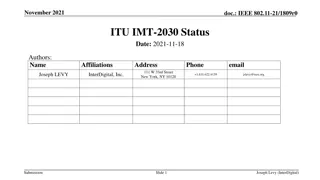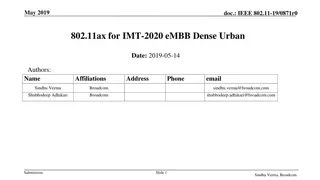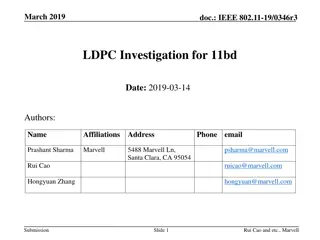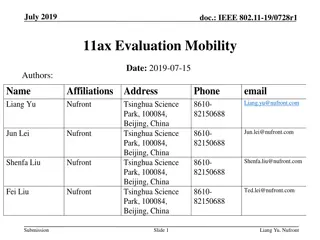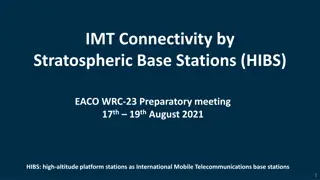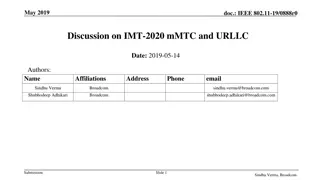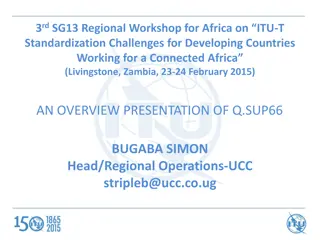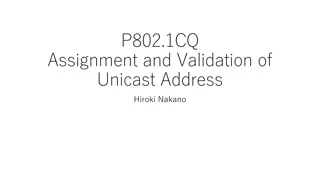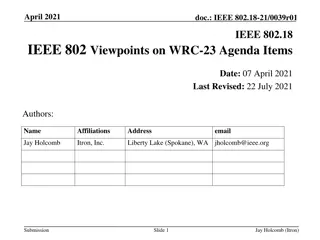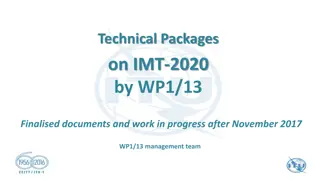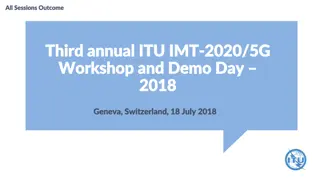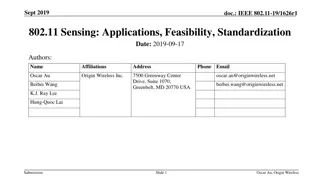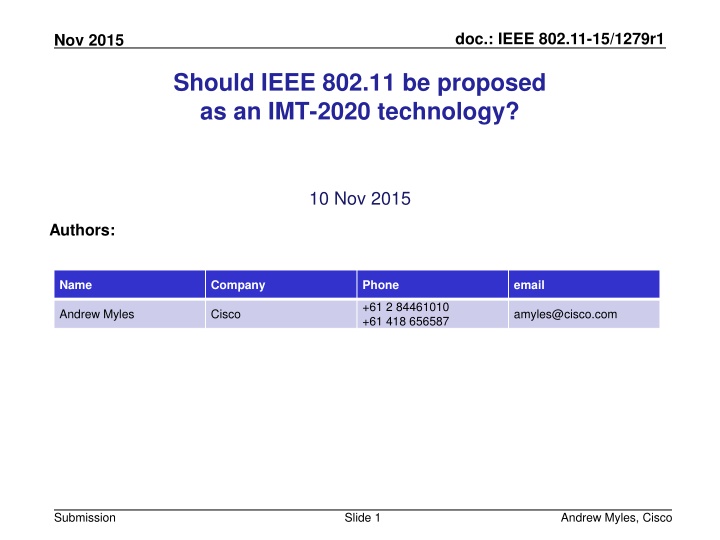
IEEE 802.11-15/1279r1 Nov.2015 Submission on IMT-2020 Integration
Discover the discussion surrounding whether IEEE 802.11 should be proposed as an IMT-2020 technology, part of the evolving 5G landscape. Delve into the potential for 802.11 to join the 5G bandwagon and contribute to the diverse use cases being considered under IMT-2020. Explore the industry's early stages in defining 5G, its technological advancements, and the implications for future communication generations.
Download Presentation

Please find below an Image/Link to download the presentation.
The content on the website is provided AS IS for your information and personal use only. It may not be sold, licensed, or shared on other websites without obtaining consent from the author. If you encounter any issues during the download, it is possible that the publisher has removed the file from their server.
You are allowed to download the files provided on this website for personal or commercial use, subject to the condition that they are used lawfully. All files are the property of their respective owners.
The content on the website is provided AS IS for your information and personal use only. It may not be sold, licensed, or shared on other websites without obtaining consent from the author.
E N D
Presentation Transcript
doc.: IEEE 802.11-15/1279r1 Nov 2015 Should IEEE 802.11 be proposed as an IMT-2020 technology? 10 Nov 2015 Authors: Name Company Phone email +61 2 84461010 +61 418 656587 Andrew Myles Cisco amyles@cisco.com Submission Slide 1 Andrew Myles, Cisco
doc.: IEEE 802.11-15/1279r1 Nov 2015 Does 802.11 want to join the 5G bandwagon currently being defined as IMT-2020? Discuss! 5G( IMT-2020) is progressing IMT-2020 will extend IMT-Advanced IMT-2020 covers many use cases Should 802.11 be part of IMT-2020? Industry is in the early stages of defining 5G IMT-2020 will cover macro cells, small cell and device to device communications Different IMT-2020 capabilities will be applied to a diversity of use cases The question for today is does IEEE 802 want to submit IEEE 802.11 as part of IMT-2020? but the definition of 5G (IMT-2020) is progressing quickly under stewardship of ITU-R WP5D with key parameters for IMT-2020 likely to significantly extend IMT- Advanced (4G) and there are a developing set of expectations for IMT-2020 capabilities for each use case There is no explicit proposal today, just the start of a conversation Submission Slide 2 Andrew Myles, Cisco
doc.: IEEE 802.11-15/1279r1 Nov 2015 Industry is in the early stages of defining 5G (aka IMT-2020) A new communications generation has been defined each decade since the mid 1980s Each generation has applied new technology to new use cases The new capabilities have driven market demand 5G - 2020s IMT-2020 Technology? Use cases? 4G - 2010s IMT-Advanced LTE/LTE-A, 802.16m Broadband data & Video 3G - 2000s IMT-2000 WCDMA, CDMA2000 Voice & Data 2G - 1990s Digital GSM, IS-95, IS-136 Voice Capacity 5G not yet been defined by any recognized standards body It is likely to be more than just than greater data capacity and coverage 1G - 1980s Analog AMPS Voice Submission Slide 3 Andrew Myles, Cisco
doc.: IEEE 802.11-15/1279r1 Nov 2015 but the definition of 5G is progressing quickly under stewardship of ITU-R WP5D Submission Slide 4 Andrew Myles, Cisco
doc.: IEEE 802.11-15/1279r1 Nov 2015 IMT-2020 will cover macro cells, small cell and device to device communications 5G Radio > 6 GHz 5G Radio < 6 GHz 5G Radio < 6 GHz 4G Radio < 6 GHz 4G Radio < 6 GHz Small Cells Unlicensed Macro Cells D2D Submission Slide 5 Andrew Myles, Cisco
doc.: IEEE 802.11-15/1279r1 Nov 2015 with key parameters for IMT-2020 likely to significantly extend IMT-Advanced (4G) Submission Slide 6 Andrew Myles, Cisco
doc.: IEEE 802.11-15/1279r1 Nov 2015 Different IMT-2020 capabilities will be applied to a diversity of use cases Submission Slide 7 Andrew Myles, Cisco
doc.: IEEE 802.11-15/1279r1 Nov 2015 and there is a developing set of expectations for IMT-2020 capabilities for each use case Data rates 1-10Gb/s Capacity 36TB/month/user Spectrum Higher frequencies with flexibility Ultra-dense networks Energy ~10% of today s consumption Latency ~1ms D2D capabilities NSPS, ITS, resilience, Ultra-reliable networks Reliabiity 99.999% within time budget Coverage Coverage Coverage >20dB of LTE Massive machines Battery ~10 years Density 300k devices per access node Source : ITU-R 2020 Vision Workshop Feb-12 2014 @ Vietnam, by METIS project Source : ITU-R 2020 Vision Workshop Feb-12 2014 @ Vietnam, by METIS project Submission Slide 8 Andrew Myles, Cisco
doc.: IEEE 802.11-15/1279r1 Nov 2015 The question for today is does IEEE 802 want to submit IEEE 802.11 as part of IMT-2020? Possible benefits of recognition as an IMT-2020 technology IEEE 802.11 would be internationally recognized of as part of IMT-2020 Note: many developing countries rely on ITU Recommendations Counter: maybe ISO standardization is sufficient? No, ISO standardization does not make you 5G! IEEE 802.11 would be included in the 5G marketing hype Counter: maybe Wi-Fi does not need any more hype? Hype always is helpful and 5G is a label that people understand! Submission Slide 9 Andrew Myles, Cisco
doc.: IEEE 802.11-15/1279r1 Nov 2015 The question for today is does IEEE 802 want to submit IEEE 802.11 as part of IMT-2020? Possible benefits of recognition as an IMT-2020 technology IEEE 802.11 might be able to access IMT-2020 identified frequency bands, including exclusive as well as shared spectrum access NOTE: May see increased use of shared-licensing as industry moves to higher frequency bands, and certain countries may require IMT-2020 compliance to deploy in these bands Counter: is this something that is needed or valuable? Yes, more spectrum opportunities for Wi-Fi is only a good thing IEEE 802.11 could be better positioned for IoT space Counter: IoT positioning requires features and not more PR! Wi-Fi need to work on IOT features anyway Submission Slide 10 Andrew Myles, Cisco
doc.: IEEE 802.11-15/1279r1 Nov 2015 The question for today is does IEEE 802 want to submit IEEE 802.11 as part of IMT-2020? Possible negatives of recognition as an IMT-2020 technology It will take lots of work Note: recognition as part of IMT-Advanced did not help IEEE 802.16, but 802.16 was a new technology, whereas IEEE 802.11 has a massive and established ecosystem Counter: the benefits make the effort worthwhile Submission Slide 11 Andrew Myles, Cisco
doc.: IEEE 802.11-15/1279r1 Nov 2015 ITU-R WP 5D already considers IEEE to be an important stakeholder, but maybe not Wi-Fi/802.11 IEEE but no Wi-Fi Alliance But other parties are invited Submission Slide 12 Andrew Myles, Cisco
doc.: IEEE 802.11-15/1279r1 Nov 2015 Maybe we can leverage 3GPP LWA to ensure IEEE 802.11 meets IMT-2020 requirements LTE-WLAN Aggregation (LWA) in 3GPP Rel-13 supports aggregation between 3GPP LTE & IEEE 802.11 at or just above the PDCP layer If certain macro-type IMT-2020 requirements cannot be met by IEEE 802.11 then we could include LWA as an option in any proposal for inclusion of IEEE 802.11 as part of IMT-2020 This would allow the proposal to meet the macro type IMT-2020 requirements through the licensed band LTE component carrier Submission Slide 13 Andrew Myles, Cisco
doc.: IEEE 802.11-15/1279r1 Nov 2015 There is no explicit proposal today, just the start of a conversation Does anyone have more information? Is there any interest? What are the next steps? Submission Slide 14 Andrew Myles, Cisco


